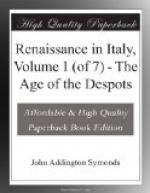In the civilization of Italy, carried prematurely beyond the conditions of the Middle Ages, before the institutions of mediaevalism had been destroyed or its prejudices had been overcome, we everywhere discern the want of a co-ordinating principle. The old religion has died; but there is no new faith. The Communes have been proved inadequate; but there is no nationality. Practical positivism has obliterated the virtues of a chivalrous and feudal past; but science has not yet been born. Scholarship floods the world with the learning of antiquity; but this knowledge is still undigested. Art triumphs; but the aesthetic instinct has invaded the regions of politics and ethics, owing to defective analysis in theory, and in practice to over-confident reliance on personal ability. The individual has attained to freedom; but he has not learned the necessity of submitting his volition to law. At all points the development of the Italians strikes us as precocious, with the weakness of precocity scarcely distinguishable from the decay of old age. A transition from the point attained in the Renaissance to some firmer and more solid ground was imperatively demanded. But the fatality of events precluded the Italians from making it. Their evolution, checked in mid career by the brilliant ambition of France and the cautious reactionary despotism of Spain, remained suspended. Students are left, face to face with the sixteenth century, to decipher an inscription that lacks its leading verb, to puzzle over a riddle whereof the solution is hidden from us by the ruin of a people. It must ever be an undecided question whether the Italians, undisturbed by foreign interference, could have passed beyond the artificial and exceptional stage of the Renaissance to a sounder and more substantial phase of national vitality; or whether, as their inner conscience seems to have assured them, their disengagement from moral obligation and their mental ferment foreboded an inevitable catastrophe.
CHAPTER IX.
SAVONAROLA.
The Attitude of Savonarola toward the Renaissance—His Parentage, Birth, and Childhood at Ferrara—His Poem on the Ruin of the World—Joins the Dominicans at Bologna—Letter to his Father—Poem on the Ruin of the Church—Begins to preach in 1482—First Visit to Florence—San Gemignano—His Prophecy—Brescia in 1486—Personal Appearance and Style of Oratory—Effect on his audience—The three Conclusions—His Visions—Savonarola’s Shortcomings as a patriotic Statesman—His sincere Belief in his prophetic Calling—Friendship with Pico della Mirandola—Settles in Florence, 1490—Convent of San Marco—Savonarola’s Relation to Lorenzo de’ Medici—The death of Lorenzo—Sermons of 1493 and 1494—the Constitution of 1495—Theocracy in Florence—Piagnoni, Bigi, and Arrabbiati—War between Savonarola and Alexander VI.—The Signory suspends him from preaching in the Duomo in 1498—Attempts to call a Council—The Ordeal by Fire—San Marco stormed by the Mob—Trial and Execution of Savonarola.




